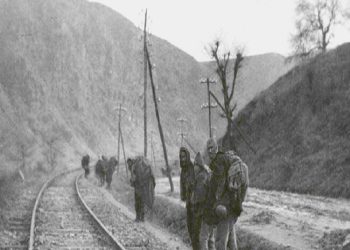Dashnor Kaloçi
The fourth part
Memorie.al publishes some archival documents taken from the Central State Archive in Tirana (fund of the former Central Committee of the ALP), belonging to 1990, where there is a record of the meeting of the secretariat of the Central Committee of the ALP which, as the main item on the agenda, had “on some issues of today’s cinematographic creativity” and in that meeting which was chaired by the First Secretary of the Central Committee of the ALP and the Chairman of the Presidium of the People’s Assembly of The People’s Socialist Republic of Albania, Ramiz Alia, in addition to the secretaries of the Central Committee such as: Foto Çami, Hekuran Isai and Lenka Çuko, also participated some of the highest officials of the party and state leadership of that time, such as: Spiro Dede, Abdyl Backa , Ali Vukatana, Sotir Koçollari, Alfred Uçi, Dritëro Agolli, Lisen Bashkurti, Skënder Gjinushi, Neritan Babamusta, Dhimitër Shandro, Marash Hajati etc. The full minutes of the meeting with conversations and discussions between Ramiz Alia and the senior party and state leadership of that time, with the main leaders from the creative sector of Kinostudio “Shqipëria e Re”, such as: Teodor Laço, Dhimitër Anagnosti and Nexhati Tafa, who dwelled for a long time on the problems of Albanian cinematography.
“Both ways seem to be rational and useful. Complete studies are also necessary, e.g. students of the directing branch at the Higher Institute of Arts, can study for directing after finishing 3-4 years of school. In general, and in other parts of the world, directors prepare after graduating from high school. Directing studies are a second school for them. In many cases, those who prepare for directing do not go to the faculties of drama or directing, but to other faculties, especially the faculties of literature. To date, we have not practiced this, but with those of the director, because at the present time usually the director of the film is also the author or co-author of the screenplay. This would be one way of full professional preparation. The second way is to prepare the staff we have with postgraduate courses with a short period of 1 year for directing. For example, this year we successfully closed a postgraduate course with 4 students of directing, who made two good films. To prepare for the first road we sent a student to France who will study 4 years of directing. However, he is the only one and, in my opinion, seeing the demands that Kinostudio has today, it is very little”!”
This was stated, among other things, in his speech at one of the meetings of the secretariat of the Central Committee of the ALP in 1990, Teodor Laço, then head of the script editorial office at the Kinostudio “Shqipëria e Re”, a meeting on “Some issues of today’s cinematographic creativity ”, which was chaired by the First Secretary of the Central Committee of the ALP and the Chairman of the Presidium of the People’s Assembly of the People’s Socialist Republic of Albania, Ramiz Alia, where in addition to other secretaries of the Central Committee, as Photo Çami, Lenka Çuko and Hekuran Isai, were also present in most of the senior party and state leadership of that time that had direct or indirect links with art and culture. For more than what was discussed in that meeting where besides Teodor Laços, from Kinostudio “Shqipëria e Re”, participated also the director Dhimitër Anagnosti and the screenwriter, Nexhati Tafa, the document in question introduces us to the minutes of that meeting, which Memorie .al publishes it in full and for the first time in some issues of the dossier section.
Followed by the last number
Minutes of the meeting of the Secretariat of the Central Committee of the ALP, with the staff of the creative sector of Kinostudio “Shqipëria e Re”
COMRADE RAMIZ ALIA: I support this principle and I, in addition to the connection of these two links, should be such that with the income of the films, Kinostudio will be able to build a cinema hall.
COMRADE ALFRED UÇI: Revenues from cinemas will be improving. There is another problem. Kinostudios films are broadcast not only in our system, but also in that of MIA, MMP, Television. For example, the television receives about 100 films a year from Kinostudio and gives them a very minimal reward. This is also the case in other institutions, so the income provided by these films is not real. In fact, the income from the movies is big, but they are not collected by Kinostudio, but remain in other pockets.
COMRADE RAMIZ ALIA: You have to study the whole economic impact of this issue.
COMRADE ALFRED UÇI: We have proposed to study now.
COMRADE RAMIZ ALIA: Do not be satisfied with just the proposal but start the study. Work on each sector must be built on an economic basis. If Radio-Television receives films from the film studio it has to pay money for them.
COMRADE ALFRED UÇI: Television pays only a symbolic amount.
COMRADE RAMIZ ALIA: He should pay as much money as you deem reasonable. Also, the Ministry of Defense, Ministry of Interior, etc. We have said that even when they need a meeting, the Palace of Congresses, the Writers’ League, or some other organization will pay for the heating and cleaning.
COMRADE ALFRED UÇI: Another problem that arose here and that should be seen well is the production of 14 films. There is no need for the sake of number to produce a non-high-quality film. But there is another risk that, if we agree today to reduce the annual amount of films, very few films can be made. Therefore, in this matter we must proceed prudently. And when we are convinced that we do not have good scripts, then we could not allow any film to be made that would increase costs in vain. However, Kinostudios must fight to ensure a minimum of backup scenarios. Attention should be focused on the qualification of screenwriters and the removal of those who do not have the necessary skills. We have 3-4 such screenwriters in the film studio. We think that for the screenwriters to organize an uninterrupted course for a period of 5 years from which one can come out every year from one. So, within this period we could provide a group of screenwriters who would better handle the work.
COMRADE RAMIZ ALIA: How many Albanian films do we have in circulation in a year?!
COMRADE ALFRED UÇI: The number has increased a lot and 200 films are released in one year.
COMRADE RAMIZ ALIA: For example, in 1990, how many Albanian films have been released by the old and the young?!
COMRADE TEODOR LAÇO: For this year, 14 new films that are being produced and 50-60 old fund films are being released. Some of these movies have been consumed.
COMRADE ALFRED UÇI: Comrade Alfred Uçi: Unlike a few years ago, now we have a reserve of films and their circulation can be done better.
COMRADE RAMIZ ALIA: The issue of film production depends on the need of the market. If we meet these needs with the existing film, adding the new film that is being produced, then the issue of producing 14 films a year will no longer be a limit. Why is the annual amount of 14 films set?! She was assigned when we had very few movies and were forced to meet the needs. This message was given after the 4th Plenum of K.Q. of the Party in 1974, when we had great difficulties and needs for our films. Now that we have over 150 Albanian films, we have the opportunity to circulate them.
COMRADE ALFRED UÇI: In recent years there has been a lot of interest in our film. From 50 thousand viewers who used to watch our movie, now their number has reached over 150 thousand. As for the foreign film from 22 thousand viewers now, it has reached nearly 200 thousand, so it has increased fivefold.
COMRADE RAMIZ ALIA: The number of viewers for foreign films has also increased, because they have started to make some new films.
COMRADE ALFRED UÇI: Maybe the import of foreign films will have to be increased. For example, if the Television has one film of ours and five foreigners, in cinemas the ratio of these films is one to one.
COMRADE RAMIZ ALIA: Television receives some films directly through foreign television stations, while the film studio cannot do that.
COMRADE PIRRO KONDI: How much does a foreign film cost?!
COMRADE TEODOR LAÇO: It does not cost more than 3 thousand dollars.
COMRADE ALFRED UÇI: It can cost another 4500 to 600 thousand dollars along with the material for reproduction. Another problem is that of a better direction by the directorate that is in Kinostudio. There is a need to improve the direction and organization of work in the film studio, from the Party Organization, Professional Unions, etc. Kinostudio has a large workforce but the lack of organization has affected the work arrhythmia. Despite the efforts and criticisms that have been made from year to year, the arrhythmia has brought an environment with the not very healthy situation in organization and direction.
COMRADE RAMIZ ALIA: I also have a couple of thoughts. It is objective that the film has a very good performance. The perspective is good, but the concerns that arise are about the themes and issues of the film because, despite the efforts that have been made, it is narrow and creates monotony. Some movies look like serials, especially those that focus on the director or the boss. This is because there is a type of director who exploits the post, a type of boss who steals or abuses. They are almost the same in every movie as they are in cowboy movies. This alienates the spectator. For example, after the movie “Shadows that are left behind”, which was a success for our cinematography, some models of this movie became. In Kinostudio there is an editorial office for the scripts which has a person in charge, Comrade Teodor. I think this newsroom should keep this issue in mind. Do not allow repetition of ideas, problems, and schemes. She goes through all the scenarios. We must therefore maintain closer ties with the creators and not allow duplication. The scenarios go to the Culture Committee, which should not allow a repetition of them.
COMRADE RAMIZ ALIA: Do you think that the Culture Committee should continue to look at the scenarios?!
COMRADE DRITERO AGOLLI: So far it has been this practice. However, the full scenarios cannot be read there. Only the topic should go there, and a summary of each scenario. The material expresses the opinion that this is the state of literature which the film reflects. I do not agree with this opinion because the film, however, has a very narrow theme. Literature has a very broad theme and is of great authority. It is not measured by the creativity of a year or six months. There have been cases where the best works of literature have been treated very badly by the film. This has happened with the novels of Shefqet Musaraj, with most of Kadare’s novels, except “The General of the Dead Army”. The works of Jakov Xoxa, Petro Marko, Migjen, Foqion Postoli, Haki Stërmilli, etc., have not been made into films at all. To put it figuratively, while the literature layer is 5 meters, the film layer is 1 centimeter. With all the respect I have for film, it does not reflect literature, because literature is one thing, and film is another.
COMRADE RAMIZ ALIA: Do you think that our literature should be used more to make films?!
COMRADE DRITËRO AGOLLI: I am of the opinion that literature should be used more and more deeply, not treated superficially. The films that are made, with rare exceptions, stand below the literary material on which they are based. There has to be a norm for doing scripts. I write a screenplay for fun, when the directors ask me for cooperation. Therefore, I am of the opinion that, if there are no real scenarios Kinostudio, as we have, for example, Nexhatiu, the necessary scenarios in quantity and quality cannot be realized. Nexhatiu could also have become a writer, novelist, narrator, I know his creativity, but he devoted himself to film, where he created his limited personality and individuality. So, screenwriters have to create screenplays, without giving up collaborating with writers. At the same time the best literary works should be exploited and harvested.
If only screenwriters do scripts, then scripting will be back in the industry. All writers have to write screenplays.
I also do not agree with the opinion that 14 films should not be produced per year. For film production there should be a margin of 13-14 films per year. This tradition has already been formed, as it happens with the publication of the newspaper. For example, the newspaper “Drita” is published once a week. Since good materials do not always appear in this newspaper, should we say that it should be published once every two weeks?! Some rules have been set for the publication of the newspaper and this issue should not be left to our desire.
COMRADE RAMIZ ALIA: There are also flaws in “Zëri e Popullit”. Are they regulated by reducing the number of newspapers?
COMRADE DRITËRO AGOLLI: Even if we remove a number of “Voice of the People”, I do not believe that the quality of writing is regulated. Even for film sessions, if we plan seven films a year, it will be claimed later that there will be five left.
While the writers and artists themselves will be looking to make more screenplays and we will need to decide later to raise the annual number of films to 16. The trend of the cinematography sector is going up.
Regarding the preparation of the directorial staff, I would say that in addition to the old studio that has been strengthened and has prepared all those staff, there is also the Higher Institute of Arts. I have the impression that we underestimate the latter. There should be specialists for film directors as well, but also for theater directors they hardly prepare. There is more of a tendency to turn the director into an actor, because in this institution there is an opinion that if you are not a good actor, you do not become a good director. It is not completely so. I am surprised that the fourth-year student at the Higher Institute of Arts has no right to stage a theatrical play or a small script of it. Even these parts are staged by professors and the student director, turns into an actor. So, he gets his degree as an actor, not as a director. The director’s degree should not be the staging of a work. Although I think that the figure of 14 films per year, not to be cut, immobile, it can be as an orientation, then whether 12 or 13 films are made, this issue can be viewed, as it can be maneuvered by producing perhaps any short film, to complete the number. /Memorie.al
Continues in the next issue

















